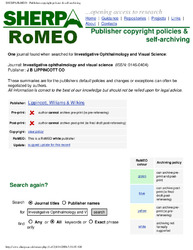| dc.contributor.author | Evans, Irene | en_US |
| dc.contributor.author | Donahue, Margret | en_US |
| dc.date.accessioned | 2006-08-14T14:35:55Z | en_US |
| dc.date.available | 2006-08-14T14:35:55Z | en_US |
| dc.date.issued | 2006 | en_US |
| dc.identifier.citation | Investigative Ophthalmology and Visual Science 47 (2006) E-Abstract 2594 | en_US |
| dc.identifier.issn | 1552-5783 | en_US |
| dc.identifier.uri | http://hdl.handle.net/1850/2274 | en_US |
| dc.description | Article may be found at: http://abstracts.iovs.org/cgi/content/abstract/47/5/2594?maxtoshow=&HITS=30&hits=30&RESULTFORMAT=1&author1=Evans&andorexacttitle=and&andorexacttitleabs=and&andorexactfulltext=and&searchid=1&FIRSTINDEX=0&sortspec=relevance&resourcetype=HWCIT,HWELTR | en_US |
| dc.description.abstract | Purpose: Regression of the hyaloid/fetal vessel system was studied in the newborn rat using confocal microscopy. The hyaloid vasculature composed of the hyaloid artery (HA), vasa hyaloidia propia (VHP), tunica vasculosa lentis (TVL), and pupillary membrane (PM) nourishes the immature lens and is present at birth along with the choroid and iris vasculatures. The retinal vasculature forms after birth even as the hyaloid vasculature is regressing and competition for blood flow between these two vascular systems may be one of the triggers for hyaloid regression. In order to investigate developmental vascular regression, the hyaloid, retinal, iris, and choroidal vessels were imaged and their remodeling documented.
Methods: The regression of the eye hyaloid vasculature and the development of the retinal vasculature were observed in the newborn rat from postpartum days 1–36 by intracardiac injection of FITC–dextran followed by scanning laser confocal microscopy and image reconstruction.
Results: The order of hyaloid vessel regression was loss of the pupillary membrane (beginning on day 8 and completed on day 14) followed by loss of the tunica vasculosa lentis (day 18–26) followed later by the vasa hyaloidia propria (day 28–36), and hyaloid artery (36–40). Retinal vasculature could be visualized in the first week after birth and its formation correlated with the disappearance of the hyaloid system. At birth, branches from the ophthalmic artery were observed to connect with the pupillary membrane and iris vasculatures. These branches into the pupillary membrane disappeared as the pupillary membrane lost its cobweb structure and regressed.
Conclusions: The scanning laser confocal microscopy imaging technique provides a view of the complexities of the hyaloid vasculature and the temporal and spatial relationships of its various parts as well as the relationships between the hyaloid, retinal, choroidal, and iris vascular systems. Depletion of blood flow to the hyaloid vessel system due to increasing diversion of flow to the developing retinal vasculature as well as the iris and choroid may induce apoptosis in the endothelial and pericyte cells. This may eventually block blood flow and hasten regression of the hyaloid fetal vasculature. | en_US |
| dc.description.sponsorship | RIT VATEA grant | en_US |
| dc.format.extent | 40100 bytes | en_US |
| dc.format.mimetype | application/pdf | en_US |
| dc.language.iso | en_US | en_US |
| dc.publisher | Association for Research in Vision and Ophthalmology: Investigative Ophthalmology and Visual Science | en_US |
| dc.subject | Eye | en_US |
| dc.subject | Scanning laser microscopy | en_US |
| dc.subject | Vasculature | en_US |
| dc.title | Confocal imaging of the regression of the rat hyaloid vasculature | en_US |
| dc.type | Abstract | en_US |

